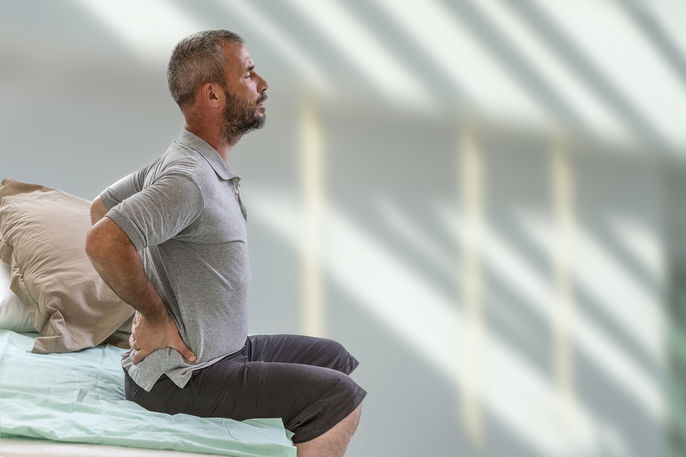Kidney stones cause symptoms like intense lower back pain, cramping, nausea, vomiting, and pain or burning with urination. These symptoms can emerge suddenly, especially if the stone is traveling toward the ureter, bladder or urethra, or if the stone is very large and becomes lodged in the kidney.
Kidney stones can vary in terms of symptom duration, location and pain intensity. Small stones usually do not cause problems and are only detected after a urine test, ultrasound of abdominal CT scan.
It is important to seek immediate medical attention if you notice kidney stone symptoms. Your doctor will order testing to confirm a diagnosis and initiate treatment to prevent complications, like a urinary obstruction.

Main symptoms
The most common symptoms of kidney stones are:
1. Intense pain in the lower back
Kidney stone pain is intense and affects the lower back or side of the body. It is generally felt when the stone is very large and becomes lodged in the kidney, or when the kidney exits the kidney and starts to descend into the ureters and bladder.
This pain is often described as similar to labor pain and can even interfere with movement.
Although it is not as common, kidney stone pain can also be described as a pressure in the lower back or side.
Learn more about other causes of back pain and how to relieve it.
2. Sharp pain that radiates to the groin or abdomen
Kidney stone pain emerges suddenly and can be so intense that it radiates to other areas of the body, like the groin, In men, the pain can radiate to the testicles, and in women, to the vagina.
Depending on the kidney stone’s transit, it can also cause lower abdominal pain.
3. Intense cramping
Renal cramping can occur in peaks of intense pain that come and go. They can last for 20 to 60 minutes, and are usually felt when the stone becomes stuck or if it blocks the urinary tract.
4. Nausea and vomiting
Kidney stones can cause nausea and vomiting, which is a common symptom. It occurs due to stimulation of the splanchnic nerves, which innervate the outer lining of the kidneys and stomach..
5. Pain or burning with urination
Pain or burning with urination may be a sign of urinary tract infection, however it can also be felt with kidney stones. This pain occurs when the stone moves to the urethra for elimination, or when the kidney stone blocks kidney flow.
6. Urinary frequency
Kidney stones can cause urinary frequency or urgency, which occur when the stone is close to the vesicoureteral junction (the area where the ureter and bladder meet).
7. Decreased urine output
Decreased urine output or inability to urinate can occur when the kidney stone totally or partially blocks the urinary tract. This can happen in the ureter, bladder or urethra.
This can lead to urine building up in the kidneys, leading to kidney swelling, or hydronephrosis. This can cause a kidney infection, also known as pyelonephritis.
8. Blood in the urine
Kidney stones within the urinary tract can cause cellular damage, leading to scant amounts of blood in the urine. This symptom is usually caused by stones that are passing through the urinary tract, or it can happen with a UTI. Check out other UTI symptoms that may emerge.
9. Cloudy or foul-smelling urine
Kidney stones can change urine color and make it appear more cloudy or concentrated. They can also give the urine a foul smell, which is usually related to a UTI or kidney infection.
10. Fever or chills
A fever or chills can also emerge in the presence of a kidney infection caused by a UTI or kidney stone.
Online symptoms checker for kidney stones
Enter your symptoms below to determine your risk for kidney stones:
Read more about symptoms associated with kidney problems that may present similarly to kidney stones.
Why does the pain come back?
Even after a kidney stone flare-up, it is common to continue feeling pressure, mild pain or burning with urination. These may be a sign that there are still more kidney stones that the body is trying to eliminate.
In these cases, you should aim to drink at least 2 liters of water per day. You can take medications that relieve pain and relax urinary muscles as prescribed by your doctor. If the main becomes very intense or if it does not improve within 2 hours of analgesics, you should proceed to the emergency room for further assessment and treatment.
Learn more about what causes kidney stones and how they are treated.
Treatment options
Treatment for kidney stones should be monitored by a urologist or family doctor. Treatment usually involves the use of analgesics (like acetaminophen) and antispasmodics (like scopolamine). If pain is very intense and does not resolve, patients are advised to proceed to an emergency room for IV medication. Many patients are usually discharged home with instructions for further assessment once they are more comfortable.
At home, treatment may continue with oral analgesics, rest, and hydration (at least 2 liters of water per day) to help with elimination of the kidney stone.
In more serious cases, when kidney stones are too large to exit on their own, surgical removal or laser treatments may be necessary to get rid of the stone. During pregnancy, treatment may only involve analgesics and monitoring.






























